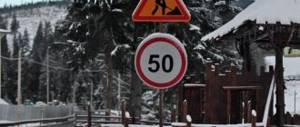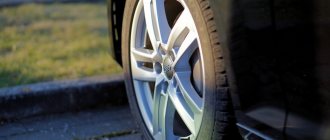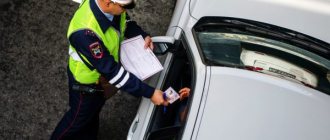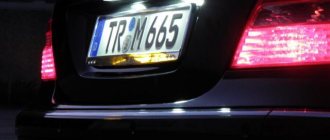New in the legislation on identification marks
The latest innovations adopted last year include a number of mandatory warning signs designed to alert other road users to the presence of certain conditions.
Thus, the legislator obliges drivers to signal with a special sign that:
- studded tires installed;
- the vehicle carries cargo that is classified as large or dangerous;
- the driver does not have appropriate driving experience;
- The driver of the car has hearing problems.
Despite the fact that a sign signaling the transportation of children is included in the list of mandatory requirements, its use is only necessary in some cases.
Are there any initiatives to introduce such a sign in 2021?
At the level of a bill or a formalized official proposal, the issue of introducing a sign “Child in the car” was not submitted to government bodies.
In the middle of the year, the traffic police conducted a survey on the website - whether such a sign is required, and also at one of the conferences, representatives of the traffic police from the public were asked a question about the possible prospects for such a sign and a request to develop its uniform type.
There were no further official movements to introduce it into the traffic rules. All the rumors about the imminent appearance of the obligation to put up a “Child in the Car” sign are just rumors.
Sign “Child in the car” according to traffic rules
The legislator clearly regulates the appearance and size of the identification sign “Transportation of children”. This is a yellow square with a red frame (10 times thicker than a side), inside of which two black silhouettes of people are depicted (as on road sign 1.23).
Regulated and exact size. For installation on the front glass - a square of 25x25 cm, on the rear - a square of 40x40 cm.
The legislator does not oblige drivers of passenger vehicles to install a “Child in the car” sign on their car. Its mandatory presence is regulated by traffic rules only for bus drivers, and if there are certain conditions.
Regulatory framework: is a “child in the car” sign necessary?
The driver’s obligation to install special signs on his car is regulated by the Road Traffic Rules. It was in them, for example, that the sign about studded tires was recently canceled in December, but the current traffic rules do not contain any provisions regarding “children’s signs”.
The obligation to mark the transportation of children with a special sign “Transportation of children” is established for vehicles carrying out group transportation of children, and is mentioned, for example, in section 22.
As for private routes and category B cars, there are no requirements for any additional signs indicating the presence of a child in the car.
Traffic regulations regarding the transportation of children establish only requirements for seating a child, his safety and oblige the driver to use special car seats for children or other acceptable safety equipment.
As you can see, there are no requirements to indicate the fact of transporting the baby.
https://www.youtube.com/watch?v=upload
Note: In a number of European countries there is an obligation to stick such a sign. So in Germany it is intended in case of a serious accident and allows rescuers to quickly determine who needs help first.
In what cases is a “Children” sign installed on a bus according to GOST?
According to the state standard, the identification plate must be installed within the framework of the current traffic regulations.
As a result of recent legal innovations, the “Beware of Children” sign is installed on the bus in all cases when the organized transportation of minor passengers is carried out. This mandatory legal norm is enshrined in clause 22.6 of the Traffic Regulations. According to GOST, installation of the “Transportation of Children” sign is mandatory both in front and behind the bus.
Organized transportation of children must meet several mandatory criteria:
- by bus, which is not a fixed-route vehicle;
- the number of minor passengers cannot be less than 8 people;
- absence of parents with children.
An exception is the appointment of legal representatives as accompanying groups.
In all other cases, the transportation of minors is not subject to this article and does not oblige the driver to use identification marks on his vehicle.
In fact, this rule is mandatory for carriers organizing the transportation of minors on charter buses, as part of children's excursions, delivery to summer camps, etc. The considered legal norms do not apply to those operating personal cars, private taxis, and shuttle buses.
Differences in signs about transporting children
Not every driver knows what the “Transportation of Children” identification sign looks like in accordance with the current traffic rules, and where to install it. Many are sure that stickers in the form of a yellow triangle or diamond, which often come with branded seats and infant carriers, are the legally accepted standard.
In fact, these two plates have nothing to do with the standard. In accordance with Decree of the Government of the Russian Federation No. 333, the carrier is prohibited from transporting minors in the absence of an appropriate identification mark, since such a trip falls under the concept of “organized”. However, a driver can easily transport a child in his car even without a yellow sticker on the rear window.
If desired, the car owner can place an identification sticker “Children in the car”, the main thing is that it does not interfere with the driver’s view, so it is better to do this on the rear window.
It is worth noting that such signs do not provide any advantage over other road users. They only attract attention, notify about the presence of small passengers in a car or bus, and signal drivers of other cars to be extremely careful, keep their distance and maneuver carefully.
Is it necessary to install a “Transportation of Children” sign on passenger cars?
Transportation of children is permitted provided that their safety is ensured, taking into account the design features of the vehicle.
Transportation of children under 12 years of age in vehicles equipped with seat belts must be carried out using child restraints appropriate for the weight and height of the child, or other means that allow the child to be fastened using seat belts provided for by the design of the vehicle, and in the front seat passenger car - only with the use of child restraints. It is prohibited to transport children under 12 years of age on the back seat of a motorcycle.
There is not a word about the sign, you can calm down, the requirements for drivers are to install a sign with dimensions of 40x40 cm.
- No. Naturally, the question remains, where and when to install it?
We continue our search in the Traffic Rules.
We can easily find the requirements for organized transportation of children in clause 22.6. 22.6. Organized transportation of a group of children must be carried out in accordance with these Rules, as well as the rules approved by the Government of the Russian Federation, on a bus marked with identification marks “Transportation of Children”.
At this point we already see a link to another document and a direct mention of the “Transportation of Children” sign. The installation of this identification mark is directly related to the organized transportation of children, which is regulated by separate additional rules.
If the goal is to find a direct requirement
Where is the safest place in a car for a child?
For a long time it was believed that the safest place was behind the driver. This theory was explained by the fact that in case of danger, the driver instinctively moves the collision away from himself, accordingly, the greatest impact falls on the opposite side. There are other opinions. It is believed that it is best to transport a child in the back, behind the front passenger seat.
According to many car owners, to ensure the greatest safety, it is enough to install a child car seat in the back row of seats. Of course, this position will reduce the load in a frontal collision, but no one is safe from an accident with a side impact or a car rollover.
Thanks to the advent of modern crash tests, specialists are able to simulate various accident situations, thereby obtaining the most accurate data, including on the safety of passengers located in different places inside the car.
Recent studies have proven that the best place to transport babies and teenagers is the middle seat in the back row. It is this place that reduces the risk of injury by 15–25% in most accidents.
The test results can be easily explained by the technical features of a passenger car:
- The center part of the rear row is subject to the least pressure as a result of body deformation.
- However, we are not just talking about side collisions. In the event of a frontal impact or rollover of a car, the main load is taken by the side parts of the roof and body. But not all cars, even modern models, are equipped with the necessary belts in this place.
At the same time, we must not forget about a high-quality car seat or seat for a small passenger, which reliably secures the baby sitting in it. Unfortunately, many parents neglect this rule, saving on the purchase of a good restraint device, or do not fasten their children, explaining this as an inconvenience for them. In this case, the percentage of injury, even in a low-speed collision, increases several times.
The car child seat must be fixed to the body with a modern ISOFIX rigid fastening system.
Recommendations for transporting a child in a car
Experts recommend adhering to the following rules when transporting children in a car:
- to install a child restraint system, choose the central place of the rear passenger seat - it is best protected from side impacts;
- for transporting babies and toddlers up to one year old - use a special car seat installed rearward;
- Before each trip, check that the car seat is securely fastened;
- do not neglect seat belts and fasten the child with them;
- the seat must correspond to the age and weight of the child, as well as the technical features of the car interior;
- refuse frameless models of child restraints - due to the latest innovations, you can receive a fine for using them;
- observe speed limits and distance while driving;
- eliminate aggressive driving methods;
- turn off the airbags where a small passenger is being transported;
- Install a sign on the rear window of the car indicating the presence of a minor in the car.
By following the unspoken rules for transporting children in a car, the driver will be able to ensure their maximum safety while driving.
Is it legal to issue a fine for not having a “Child in the car” sign?
If the driver has any doubts about the legality of issuing fines and their amounts, it is necessary first of all to refer to the current traffic rules and legislation. After all, a sanction can be imposed only in case of violation of a legal norm established by the legislator.
In the situation under consideration, drivers of passenger vehicles are not required to install a special sign when transporting children. Modern models of such cars do not provide for the transportation of more than 8 people. This means that the driver does not face liability in the form of a fine for the absence of an identification sticker.
Another thing is the driver of a bus, who is subject to the rules regulating the organized transportation of minors. In the absence of a sign, the size and appearance of which is established by the rules of traffic rules and GOST, the offender may be brought to administrative responsibility.
Why do drivers put up a “Child in the car” sign?
The choice of a wide variety of “Child in the Car” signs in auto stores and even outlets that do not have auto sales is great. This sign has become, first of all, a means of warning, although it is not required by traffic rules, and only then - still a car decoration, like a sticker, for example, of the logo of a favorite game or team.
According to drivers (mostly women), a sticker notifying them of the presence of a child in the car allows them to:
- To neutralize the negativity in traffic conflicts, since the presence of a child in the car often cools down the opponent;
- Apologize for excessively careful driving or low speed;
- Warn other drivers to be especially careful when approaching a car: after all, a car with a child, for example, on the highway can suddenly stop if the baby starts crying or chokes on something.
All this is just the opinion of drivers and their confidence in the usefulness of this sign. Another part of car enthusiasts considers this sign to be absurd and of no practical use.
What is the punishment if there is no identification mark?
For the absence of mandatory signs on the rear or front window of a car, an administrative sanction in the form of a fine of 500 rubles may be applied to the driver. At best, the traffic police officer will only issue a warning.
Within the framework of the issue under consideration, it should be noted that Art. 12.23 of the Code of Administrative Offenses of the Russian Federation provides for driver liability for improper transportation of minors. In case of violation of traffic rules, he faces a fine of 3 thousand rubles.
You can also receive a fine of 500 rubles for having a “Children in the car” sticker if it is attached to the windshield and interferes with the driver’s view, which is also a violation of clause 7.3 of the current traffic rules.











